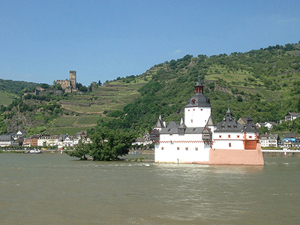The year 610 trail
The later pilgrimage trails

After spending 20 years in the vicinity of Luxeuil, where he successively founded three abbeys, Columbanus was banished from the kingdom by Queen Brunehaut, along with all the Celtic monks; ordered to return to Ireland. Aged nearly 70, he was escorted across France to the western port of Nantes, under armed escort. There he escaped with his disciples, and headed back north-east, to the Rhineland, then up through modern day Luxembourg, Germany, Switzerland, Austria and Liechtenstein, where he crossed the Alps on his way to Italy.
610 Chemin de saint Colomban - France
 Expelled from Luxeuil with the Irish and Breton monks, Columbanus and his family were taken to Nantes under the guard of armed soldiers charged to embark them on a ship for Ireland. Already on board the ship, they managed to escape, and began a second epic journey across Europe, passing through seven modern-day countries.
Expelled from Luxeuil with the Irish and Breton monks, Columbanus and his family were taken to Nantes under the guard of armed soldiers charged to embark them on a ship for Ireland. Already on board the ship, they managed to escape, and began a second epic journey across Europe, passing through seven modern-day countries.
This 'trail of exile' crosses France from East to West, to the Atlantic port of Nantes; then back East towards the lower Rhine. The route follows mainly the large rivers, alongside vineyards that are often planted on their banks, crossing though the many historic cities.
This 2600km route is divided into eight parts that can be traveled separately or successively. They can be accessed through the following links:
610 Kolumbansweg - Germany then Switzerland
 Columbanus' route reaches modern-day , following the Moselle north to Koblenz. From there, he sailed southwards up the Rhine to Switzerland, then to Bregenz in Austria where he founded a fourth abbey. His disciple Saint Gall remained in the vicinity of Lake Constance, where the Swiss city of St.Gallen carries his name.
Columbanus' route reaches modern-day , following the Moselle north to Koblenz. From there, he sailed southwards up the Rhine to Switzerland, then to Bregenz in Austria where he founded a fourth abbey. His disciple Saint Gall remained in the vicinity of Lake Constance, where the Swiss city of St.Gallen carries his name.
In these stretches of the route, the Via Columbani runs largely next to rivers or lakes, which are also navigable. Then, in Switzerland, the trail gradually becomes more mountainous, passing through green valleys, before heading up into the Alps to cross into Italy through the Septimer Pass.
The routes in Germany (470km) and Switzerland (465km) are accessible through the following links:
610 Via Columbani and 610 Cammino di San Colombano - Italy
 Fearing to be overtaken by Queen Brunehaut, whose kingdom was expanding eastwards, Columbanus crossed the Alps, stopping for a while in Milan at the court of the king and queen of the Lombards, who gifted him land to found his last abbey in Bobbio, northern Italy, where he died at the age of 72, in 615.
Fearing to be overtaken by Queen Brunehaut, whose kingdom was expanding eastwards, Columbanus crossed the Alps, stopping for a while in Milan at the court of the king and queen of the Lombards, who gifted him land to found his last abbey in Bobbio, northern Italy, where he died at the age of 72, in 615.
The descent frrom the Alps runs along Lake Como, then crosses the plain of the Po river. On the other side, it rises up into the Appenines, where the landscape changes dramatically, through hillsides with vineyards and small villages, rich in history.
To reach Bobbio, the Via Columbani proposes two possible routes, one passing through San Colombano al Lambro; the other through Pavia:
- San Colombano al Lambro (320km): 17. 610 Italy (1/2)
- Pavie (330km) : 18. 610 Italy (2/2)
